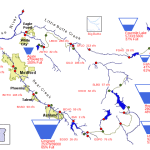Analysis by Dean Silver

The Croman Mill site remediation came under scrutiny at the City Council business meeting last night. You can view the agenda item here.
Background
From the agenda item:
“The former mill site consists of approximately 70-acres and was home to planning and sawmill operations for 62 years, from 1934 – 1996. At the time that mill operations were abandoned, the property contained an abundance of decommissioned equipment, construction materials and piles of debris and organic material from log decks. The property owners began preparing the site for development by clearing the equipment, materials and buildings after the Croman Mill District Plan was adopted by the City in 2010.
“In 2012, the property owners began a reclamation process to remove layers of organic material from the northwest corner of the site in the former log deck area. Over a several year period, on-site activity changed from site reclamation to the manufacturing and processing of quality soil amendments. At that time, the agent for the property owner indicated that sales from the production of soil amendments assisted in financing the ongoing clean-up of the site, which became more widespread compared to what had been initially anticipated. Overtime, it became apparent that the manufacturing and sale of soil amendments as well as importing and depositing fill material on the site appeared to overshadow the goals of the original reclamation proposal.”
Staff Recommendation
From the agenda item:
“Excavation and earth moving activities occurring on the property over the past 10 years has been and continues to be a major cause of frustration for surrounding property owners. In 2010, the owners of the Croman Mill site agreed to and supported the adoption of the Croman Mill District Plan and implementing Land Use Ordinance code chapter. At that time, they estimated the clean-up would take two to three years. They did not expect the challenges presented during excavation, largely brought on due to the site being used as a dumping ground (surface and subsurface) for a variety of debris and waste materials over six decades. Debris that includes wood waste, machinery parts, concrete and asphalt, tires, construction debris, abandoned vehicles, etc.”
The testimony made clear that material has been imported into the site at times over the past ten years, which was, according to Bill Molnar, “a violation of the Croman Mill district zoning code”. He stated that is no longer the case.
Citizen Input
The final section of the agenda item is a letter from Mark DiRienzo, a neighboring business owner. He has been raising the issue of unpermitted earth moving activities on the site with the Planning Staff for many years. He has been unable to receive a satisfactory explanation as to why the observed activities have been allowed to proceed without proper city permitting. The issue has come to a head recently because the Oregon Department of Environmental Quality (DEQ) has identified contamination at the site.
The operations at the site often generate clouds of dust. Those clouds of dust, which we now learn may contain dangerous contaminants, have been observed blowing toward the Belleview School, as well as nearby residential neighborhoods. It appears that this is the issue that spurred Council to review the situation.
As with all issues regarding land use planning in Ashland, the situation is complicated and not at all clear cut. The owners have a potential buyer and developer for the property. Much of the material found at the site must be removed before it can be developed. Some of that material may be contaminated with unknown substances. The owners apparently have been selling much of that material without proper permitting. A grading permit has been issued to the owner, but it is not clear whether that permit allows for the current operations on site.

The Council’s Response
Bill Molnar, Director of the Department of Community Development (AKA the Planning Department) and Brandon Goldman, Senior Planner made their presentation to the Councilors. They were soon joined by Derek Severson, another Senior Planner.
Councilor DuQuenne wanted to know the dates that material was imported onto the property. The answer was 2012-2020, when the grading permit was issued.
Councilor Jensen asked, “Help us understand why there was never any permit issued for this massive project.” He went on to state, “it is a fact, and I’ve seen with my own eyes today the hauling of quality products from the Croman Mill site continues unabated to this very day.” He went on to describe a conversation with a truck driver at the site who explained that material was being hauled off for sale, and that to his knowledge, no unsalable material was being removed. Derek Severson stated that logs indicate that contaminated material was, in fact being removed.
Councilor Jensen continued. “Please clarify as why a grading excavation permit without any public process was issued by this building department…. On the surface, and in the eyes of the Croman neighbors, this grading excavation permit seems much more like a workaround to continue an unpermitted use rather than a bona fide construction permit that will regulate impending building construction….” Bill Molnar replied that public input is not required for the issuance of a grading permit, and attempted to explain the purpose of grading permits.
Brandon Goldman explained that the operations taking place were beneficial in that they were an attempt to recycle as much of the material as possible, and prevent the hauling of any more material than necessary to the landfill. He did not address the question of the business aspects of the operation, namely, selling some of that reclaimed material without proper permits.
Councilor Hyatt expressed concern regarding the lack of a business license for these operations. She also noted her concern regarding potential health hazards from any contamination. Severson replied that DEQ has been monitoring the operations at the site for years, and that as of 2019 had stated that the owners were following “best practices” regarding the removal of material, and that there were no violations. Molnar pointed out that the local DEQ representative had retired in 2019, so that the issue is now being monitored by the Eugene office of DEQ, which may have led to a reduction of oversight.
Councilor Moran expressed his concern regarding contamination, and also that while the Croman Mill master plan had been approved in 2010 for development, the cleanup is ongoing twelve years later. He inquired as to how long this was going to take. Molnar replied, “I wish I knew how long it would take to clean up.” He added, “I feel that they are very serious about ultimately acquiring, and coming before this body to talk about possible changes to master plan is very enlightening, enheartening.” The mention of changes to the master plan was unexpected, and not directly related to the discussion at hand. Later, he mentioned a possible two to three year time frame for completion of the cleanup, but made it clear that was speculative.
Mayor Akins suggested that the discussion was important, but that there were other time sensitive items on the agenda. She suggested that the discussion be continued at a future study session.
But Councilor Jensen was not to be deterred. He moved, “to direct planning staff to bring back to City council at the next meeting, the continuation of this presentation if possible, but more specifically truck log info, sale of materials sold, and waste loads hauled off—numbers—and the next one, even more importantly, a new and better monitoring process for specific stop work provisions for violations.” Hyatt seconded, and stated that Council needs more information.
Goldman suggested that they would not have the required information from DEQ in time for the next Council meeting, and suggested that September would be a better time to continue the discussion. The Mayor asked if anyone would like to amend the motion. Jensen demurred, stating that he wanted the other information requested as soon as possible. The motion passed, 6-0.
It is unusual that Council would interrogate and challenge staff in this manner, but their concern was palpable.
To be continued.






